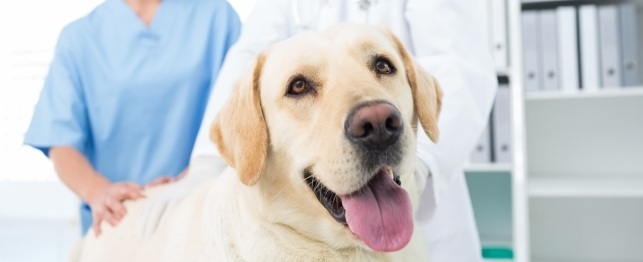Dog communicate with us in the only way they can, which is through actions and verbally. Once you recognize what they are saying it will ultimately make sharing your lives together much easier and happier.
Most devoted dog owners can immediately tell what their dogs are feeling by different body language signals. Most dogs have similar and repetitious signals that are generally easy for someone who understands their dog, will then help understand a friendly dog on the street, or in a dog park, from a potential enemy.
If you are not sure of what a dog is saying check out these few different examples that I have learned from my dogs, Lady and Lola.
A Happy, Friendly Tail Wagging Dog:
The tail will make wide sweeps or almost a circle movement, with the tail hanging down, and not held straight up and wagging stiffly. The ears are relaxed and fur will be smooth down the spine and shoulders. A happy tail wagging dog won't look another dog or you in the eyes, but will be busy with the task of sniffing, usually first nose to nose, then nose to butt, moving in a relaxed manner. Ask the owner if it is okay to pet their dog after the sniffing routine is finished, then offer the back of your hand to smell first before petting. I usually just stand with my fist turned towards the unknown dog at this point, staying fairly still with my arm hanging down at snout level. I allow the dog to approach me rather than sticking my fist out towards him. So far I haven't had a problem with misinterpreting this action as aggressive.
Showing Aggression Through Tail Wagging:
If you meet another dog while out with yours, or even if you are just out alone don't assume he is friendly because his tail is wagging. Although the strange dog is not growling, showing it's teeth and snapping at you, he can be dangerous. If his tail is stiff and held high, and the ears seem alert, and he stares directly into your or your dog's eyes, then you are encountering a hostile dog. The hackles are raised. - ( the fur down the spine and around the shoulders ). To prevent attack you should try to quietly remove yourself and your dog quickly, without running of course.
A Happy Playful Pup:
This is my favorite way for Lady or Lola to show me their "mood". Most people will recognize this type of dog language, even people who aren't dog people. Let's play. Your dog bows down and rests on the chest and front elbows, with the butt swinging happily up in the air. Sometimes after a short display of this, they get up, bark, run in circles, do a quick roll around, and return to the position. I can never resist this request.
A Very Unhappy Fearful Dog:
The whole body will be lowered, and tucking the tail to cover it's scent will be a good indication that your dog is afraid of something. The ears are usually laid back and tight against his head, and the fur is raised along the back and shoulders. Fear biting is sometimes a result when a dog is afraid. This is a dog you want to retreat from quietly and quickly.
A Submissive Dog:
When a dog is being submissive, it may lie on his back and expose the belly. This is not a sign of cowardice. This is your dogs way of giving you top position, which in turn leaves him the ease of being relaxed and enjoying his wonderful life. This type of laid back, relaxed dogs are saying I just want love, and are not looking for a fight. This is a good dog to bring into your home and become one of the pack. As long as there are no other symptoms to go along with this behavior that would indicate the dog shows obsessive behavior along with this body language, or is so timid that is hides all the time and is truly a "scaredy dog". I had a sweet, sweet beagle named Susie that was so submissive and afraid of everything that it took over one year just for her to trust me enough to approach me. She stayed mostly under the bed and I was always hunting around the house for her. I rescued Susie from a horrible existence in a puppy mill, at the age of 6 months. It took a lot of quiet patience and work but she turned into a wonderful pet and she was with me for 10 years before she died of cancer.
Obviously these few examples above of "dog body language" are just that - a few. Dog's have many actions, expressions and stances that indicate different wants and needs. Traits that are explained here, and many more, are genetically passed on and were orginally wild dogs way of communicating with each other, rather than humans.
Learning to read the different variations within your dog's body language makes living together a very rewarding endeavor.

 How to Cure a Dog With a Stomach Ache
How to Cure a Dog With a Stomach Ache
How to Cure a Dog With a Stomach Ache
How to Cure a Dog With a Stomach Ache
 CHF and Zoetis Podcast Series Pregnancy Diagnosis
The AKC Canine Health Foundation (C
CHF and Zoetis Podcast Series Pregnancy Diagnosis
The AKC Canine Health Foundation (C
 Keeping your Dog off (Harmful) Drugs
Keeping your Dog off (Harmful) Drugs
Keeping your Dog off (Harmful) Drugs
Keeping your Dog off (Harmful) Drugs
 How to Have a Trauma-Free Vet Visit For Your Dog
How to Have a Trauma-Free Vet Visit For Your
How to Have a Trauma-Free Vet Visit For Your Dog
How to Have a Trauma-Free Vet Visit For Your
 Moving With A Dog
Moving with Pets
Moving acro
Moving With A Dog
Moving with Pets
Moving acro